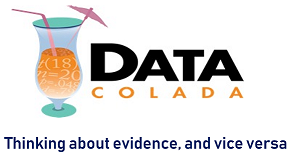This post shares a shocking and counterintuitive fact about studies looking at interactions where effects are predicted to get smaller (attenuated interactions).
I needed a working example and went with Fritz Strack et al.’s (1988, .html) famous paper [933 Google cites], in which participants rated cartoons as funnier if they saw them while holding a pen with their lips (inhibiting smiles) vs. their teeth (facilitating them).

The paper relies on a sensible and common tactic: Show the effect in Study 1. Then in Study 2 show that a moderator makes it go away or get smaller. Their Study 2 tested if the pen effect got smaller when it was held only after seeing the cartoons (but before rating them).
In hypothesis-testing terms the tactic is:
| Study | Statistical Test | Example |
| #1 | Simple effect | People rate cartoons as funnier with pen held in their teeth vs. lips. |
| #2 | Two-way interaction | But less so if they hold pen after seeing cartoons |
This post’s punch line:
To obtain the same level of power as in Study 1, Study 2 needs at least twice as many subjects, per cell, as Study 1.
Power discussions get muddied by uncertainty about effect size. The blue fact is free of this problem: whatever power Study 1 had, at least twice as many subjects are needed in Study 2, per cell, to maintain it. We know this because we are testing the reduction of that same effect.
Study 1 with the cartoons had n=31 per-cell. [1] Study 2 hence needed to increase to at least n=62 per cell, but instead the authors decreased it to n=21. We should not make much of the fact that the interaction was not significant in Study 2
(Strack et al. do, interpreting the n.s. result as accepting the null of no-effect and hence as evidence for their theory).
The math behind the blue fact is simple enough (see math derivations .pdf | R simulations| Excel Simulations).
Let’s focus on consequences.
A multiplicative bummer
Twice as many subjects per cell sounds bad. But it is worse than it sounds. If Study 1 is a simple two-cell design, Study 2 typically has at least four (2×2 design).
If Study 1 had 100 subjects total (n=50 per cell), Study 2 needs at least 50 x 2 x 4=400 subjects total.
If Study 2 instead tests a three-way interaction (attenuation of an attenuated effect), it needs N=50 x 2 x2 x 8=1600 subjects .
With between subject designs, two-way interactions are ambitious. Three-ways are more like no-way.
How bad is it to ignore this?
VERY.
Running Study 2 with the same per-cell n as Study 1 lowers power by ~1/3.
If Study 1 had 80% power, Study 2 would have 51%.
Why do you keep saying at least?
Because I have assumed the moderator eliminates the effect. If it merely reduces it, things get worse. Fast. If the effect drops in 70%, instead of 100%, you need FOUR times as many subjects in Study 2, again, per cell. If two-cell Study 1 has 100 total subjects, 2×2 Study 2 needs 800.
How come so many interaction studies have worked?
In order of speculated likelihood:
1) p-hacking: many interactions are post-dicted "Bummer, p=.14. Do a median split on father's age… p=.048, nailed it!" or if predicted, obtained by dropping subjects, measures, or conditions.
2) Bad inferences: Very often people conclude an interaction 'worked' if one effect is p<.05 and the other isn't. Bad reasoning allows underpowered studies to "work."
(Gelman & Stern explain the fallacy .pdf, Nieuwenhuis et al document it's common .html)
3) Cross-overs: Some studies examine if an effect reverses rather than merely goes away,those may need only 30%-50% more subjects per cell.
4) Stuff happens: even if power is just 20%, 1 in 5 studies will work
5) Bigger ns: Perhaps some interaction studies have run twice as many subjects per cell as Study 1s, or Study 1 was so high-powered that not doubling n still lead to decent power.
(you can cite this blogpost using DOI: 10.15200/winn.142559.90552)
- Study 1 was a three-cell design, with a pen-in-hand control condition in the middle. Statistical power of a linear trend with three n=30 cells is virtually identical to a t-test on the high-vs-low cells with n=30. The blue fact applies to the cartoons paper all the same. [↩]

